Growing castor beans from seed can be a bit challenging at first. But once you get the hang of it, you’ll be able to easily grow them every year.
In this post, I am going to give you all the details you need, and show you exactly how to grow castor seeds step-by-step.

Castor bean (Ricinus communis, aka: mole plant) is a fast growing tropical plant, and it’s one of my favorite annuals. I love the red ones especially, they add a wonderful contrast of color and texture to my garden.
I get tons of compliments on them, and everyone asks what they are. I start them from seeds every year, and they grow to be monsters by the end of summer.
Below I am going to show you exactly how to grow castor beans from seed so you can enjoy them in your garden too. I’ll cover everything from start to finish.
This includes which method to use, when to start, step-by-step planting instructions, germination time, and seedling identification.
I’ll also give you tons of seedling care and transplanting tips, show you how to fix common problems, answer your faqs about germinating castor bean seeds, and more!
Toxicity Of Castor Plant Seeds
It’s true that castor plants are beautiful additions to the garden… but be careful with this one. All parts of the plant and the seeds are poisonous if ingested.
You might not want to grow it in your garden if you have pets or kiddos running around. At minimum, you should keep the seeds out of reach of children and pets at all times.
Growing Castor Bean From Seed
Below I am going to give you everything you need to know to successfully grow castor beans from seed. It doesn’t matter which type you have, the steps for planting and germination are the same for all.
Types Of Castor Seeds To Grow
There are several varieties of castor plants, and all of them are easy to grow from seed. The most common ones have green leaves, but I love the red leaf ones the best.
There are also giant varieties that can grow to be upwards of 20′ tall, with huge leaves. And others that have curled leaves that also look amazing in the garden.
What Do The Seeds Look Like?
Castor bean seeds are sometimes referred to as “dog tick seeds”. That’s because they look very similar to wood ticks when they are engorged with blood.
Gross, I know, but it’s the best way to describe them! Haha! Let me see if I can give you a less disgusting description…
Castor seeds are large, oval shaped, and have a pretty spotted pattern on them. One end of the oval has a small nub that sticks out slightly. They are usually brown or reddish in color, but sometimes can look more gray.
Recommended Ricinus Seed Starting Methods
If you live in a warm enough climate, you can sow castor plant seeds directly into the garden. But for most of us, they need to be started indoors.
That’s because they require quite a long growing season to mature to full size. Plus, it can take a long time for the seeds to germinate.
Related Post: 3 Seed Starting Methods That Every Gardener Should Try
When To Plant Castor Bean Seeds
To give them the biggest head start, it’s best to plant them indoors 6-8 weeks before your average last frost date.
That exact date varies depending on where you live. So if you don’t know it, then be sure to look it up. In zone 4b, ours is around May 15th, so I start mine sometime in early April.
Tips For Growing Castor Bean From Seed
Since growing castor bean seeds is different than it is for other plants, there are a few things to consider before sowing them.
Soaking them first will give them a much better chance of germinating. And it’s also important to be sure you use the proper container to make things easier on yourself and the seedlings.
Soaking Castor Bean Seeds
The first step for successfully germinating castor seeds is to soak them in warm water for 24 hours before sowing.
To give them even more of a boost, try soaking them in diluted organic fish emulsion, liquid kelp or compost tea. After soaking the seeds, it will look like one end has popped out – this is normal.
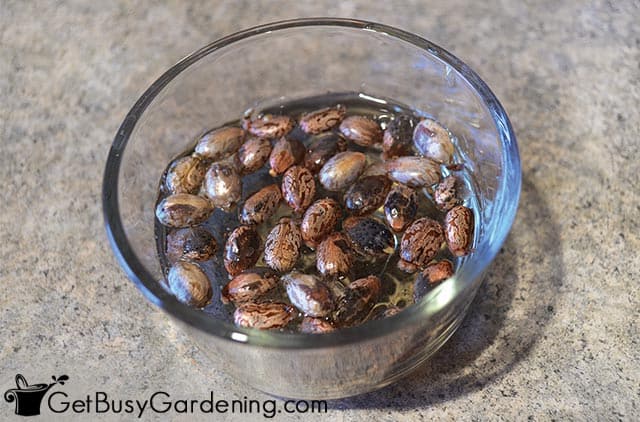
Choosing The Best Containers
It’s a good idea to plant castor oil plant seeds in a deep container, unless you plan to transplant them shortly after they start to grow.
Once they have germinated, the seedlings will grow very quickly. So it only takes a few days for them to outgrow seed starting trays.
You could start them directly in plantable peat pots to make transplanting them to the garden a snap.
If you prefer to use something more sustainable than peat, try coco coir or cow pots instead. Otherwise, plastic seedling pots are perfect (and reusable).
How To Plant Castor Bean Seeds Step-By-Step
You don’t need any special equipment to grow castor bean seeds, but you’ll definitely need a few things. If you do a lot of seed starting, then you’ll already have this stuff on hand…
Supplies Needed
- Plantable pots, reusable plastic pots, or a seeding tray
- Seed starting soil or large peat pellets
- Plastic wrap or a clear bin (if your container doesn’t have a lid)
- Seeds
- Water
- Heat mat (optional, but highly recommended)
Step By Step Instructions
Step 1: Add soil to the seed trays – Fill your container will a high quality seed starting medium. Or you could use pre-moistened large peat pellets instead, and place them into the tray.
Step 2: Drain the water (optional) – You can either drain the water from the seeds, or just pull each one out of the water as you work to plant them. Either way is fine, just make sure they don’t dry out. Also, take care not to damage the little nub that’s sticking out as you work.
Step 3: Plant the seeds – Make a hole in the dirt to the proper depth (they should be planted 1 – 1 1/2″ deep), and drop a seed into the hole. It doesn’t matter which side is up, the seedlings will find their way to the top.
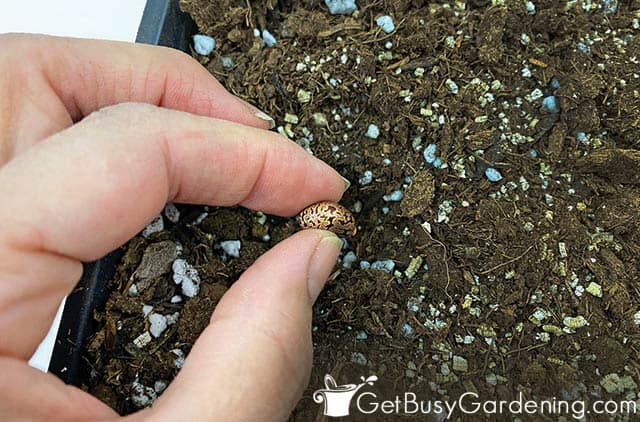
Step 4: Cover the seeds with soil – Bury each one with soil, and then gently press it down. You want to make sure the soil comes in contact with the seeds, but don’t pack it down too tightly over them.
Step 5: Cover the containers – If your container doesn’t have a clear plastic lid, then cover it with plastic wrap. Or you could put them into a large plastic bin with the lid closed to keep the soil moist during germination.
Step 6: Place them in a warm spot – Ideally, you should place them on top of a heat mat, which will speed up germination. Otherwise, put them in the warmest spot you can because they need warm soil to grow.
Step 7: Keep the soil evenly moist – As you wait for the seeds to germinate, be sure to keep an eye on the soil so it doesn’t dry out. It should stay evenly moist, but never allow it to get soggy. Soggy soil can cause the seeds to rot.
Castor Bean Germination Time
It can take a long time to germinate castor seeds, so be patient. The typical germination time is 10-21 days. I’ve had some take as long as a month before finally sprouting, so don’t panic if it takes longer.
The good news is that you can help to speed up germination! The key is keeping the soil nice and warm by adding bottom heat.
So be sure to use a seedling heat mat to help castor bean plant seeds germinate much faster, and lower the risk of rot.
What Do Castor Bean Seedlings Look Like?
As the seedlings emerge from the soil, they look very similar to bean seedlings. The color will vary, depending on the variety you’re growing.
The photo below is red castor bean seedlings emerging from the soil, that’s why they’re pink. Once they start to emerge, they will pop up very quickly.
The first two leaves that grow, called the “seedling leaves”, will be oval shaped. The next leaves to grow after that are called the “true leaves”, and those look like tiny baby castor plant leaves.

Castor Seedling Care Tips
The seedlings can be a bit difficult to care for indoors. So, for the best success, be sure you read through the following care tips before your seeds start germinating. You can also learn more about general seedling care here.
Light
After the seeds finally germinate, the seedlings will grow very fast. So, as soon as you see them popping out of the dirt, add a grow light right away.
Since they grow so fast, a grow light is a must to prevent castor bean seedlings from getting too tall, weak and leggy.
I made my own seed starting grow lights using an inexpensive florescent light fixture and plant grow bulbs, which works great.
Make sure the light hangs an inch or two above the seedlings at all times, and keep it on for 14-16 hours per day. Use an outlet timer to make it easy to control the lights. Check a few times per day, and adjust the height of the light as the seedlings grow taller.
Related Post: A Beginner’s Guide To Grow Lights For Seedlings
Water
Consistent watering is also very important to the health of your castor seedlings. Keep the soil evenly moist, but never wet or soggy. And never allow it to dry out completely.
Give your seedlings a good drink until water starts coming out of the drainage holes, then dump the excess out of the trays. Never leave them sitting in water.
Fertilizer
Once your castor bean plant seedlings grow their first set of true leaves, it’s time to begin fertilizing them.
I prefer (and highly recommend) using an organic fertilizer like fish emulsion or a compost tea solution. (The fish emulsion can get a little stinky indoors, so you may want to use that outside only.)
You could also buy compost tea bags, and brew your own. Whatever kind you decide to use, start with a weak, half dose of liquid fertilizer, and gradually increase it to full strength over time.
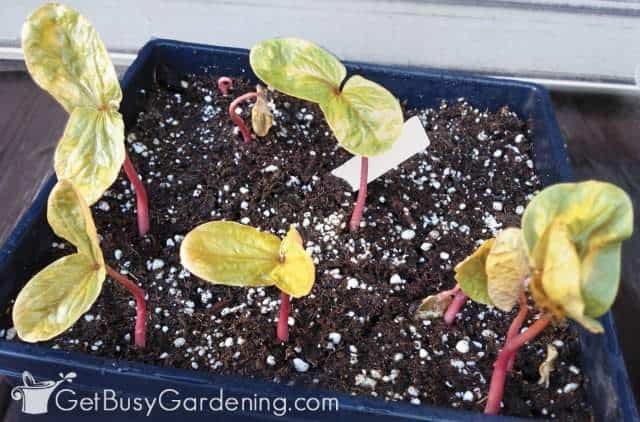
Air Circulation
After your castor seedlings have popped up out of the soil, it’s a good idea to add some airflow. Remove the lids to prevent mildew growth, and run an oscillating fan over them on low to strengthen them up.
You can run the fan for a few hours a day at first, to get them used to it. Then, if you want, you could plug it into the same outlet timer as your lights to make it easy.
Thinning
If you planted more than one seed per hole, then you’ll definitely want to thin out the weakest one. Wait until the seedlings have grown to be a few inches tall, and then remove the smallest/weakest one.
Don’t pull them out though, or it could damage the tender roots of the healthy seedling. Instead, cut it off at the base using a pair of micro-tip snips or bonsai shears.
Repotting
If you planted your castor seeds in small containers or cells, then you’ll need to pot them up once they’re 3-4″ tall to give them plenty of room to grow larger.
Using plantable pots will help ease the transition into the garden, and lower the risk of transplant shock. My favorite types to use are peat pots, ones made out of coco coir, or cow pots.
Otherwise, 4″ plastic nursery pots are the perfect size, and you can reuse them year after year. For soil, either use the same seedling mix you planted the seeds in, or you can use regular potting soil.
Transplanting Castor Bean Seedlings Into Your Garden
After all the hard work and patience it takes to grow castor beans from seed, you don’t want to lose them by planting them outside too early.
So follow the tips below to give them a healthy transition, and learn exactly when to transplant castor seedlings into your garden.
When To Transplant
Castor bean plants hate the cold, so it’s best to wait to plant them, rather than risk doing it too early. If the soil or weather is too cold, the seedlings could die, or their growth could be stunted.
So wait to transplant them into the garden until after all chance of frost is gone, and the soil has warmed up in the spring.
Hardening Off
Before you can plant your castor bean seedlings in your garden, they must to be hardened off to get them ready for life outdoors. Do not skip this step!
Start this delicate transition a few weeks before you plan to transplant them into your garden. Place the seedlings outside in a shady, protected spot for a few hours a day, then bring them back indoors.
Each day, give them a little more time outside, and gradually move them into the sun. After a few weeks, they’ll be toughened up and ready to move to the garden.
Where To Plant Castor Seedlings
Castor bean plants need a full sun location, and lots of heat to grow their best. They will tolerate shade, but the plants will stay small.
Choose a location in your garden where they will be protected from high winds. It’s best to grow them in fertile soil that drains quickly. They like a lot of water, but they don’t like soggy soil.
You certainly could plant them in a large pot, but their growth will be stunted. So a nice, sunny garden location is best.
Related Post: How To Care For Castor Bean Plant (Ricinus communis)

Spacing
Since castor plants grow very large, they need quite a bit of space. Plant the seedlings 36-48″ apart for best results. If they are overcrowded, the plants may not grow very large.
Some varieties grow much bigger than others, so it’s best to research the type you have to give them adequate space.
Seedling Planting Depth
For the best success, plant castor seedlings into your garden at the same depth that they were growing in the container.
Planting them too shallow could expose their delicate roots. While planting too deep could cause them to rot at the base.
Troubleshooting Common Problems
There’s nothing worse than putting all the time and effort into growing castor beans from seed, only to have nothing but problems with them. Especially if you don’t know what’s wrong, or how to fix it!
So here I will list a few of the most common things that may go wrong. You can read more about fixing common seedling problems here.
Castor Seeds Not Germinating
Lack of germination can be caused by a few things: the seeds are old or immature, and therefore not viable, or they could have rotted if the soil was kept too wet. Or maybe they are just really slow, and you need to give them more time.
Leggy Seedlings
This is definitely one of the most common problems for castor seedlings! Since the seedlings grow so fast, they need lots of light, and they need it from the moment they pop out of the dirt. Otherwise, they will quickly grow tall and leggy.
Seedlings Growing Crooked
Lack of light can also cause the seedlings to grow crooked, and reach for the nearest window. So be sure to add a grow light asap (a sunny window is usually not enough).
Seedlings Not Growing
If the seeds germinated, but the seedlings aren’t growing any larger, they may have outgrown their container. If that’s the case, pot them up into a larger one. Otherwise, stunted growth may be caused by either overwatering, or it’s too cold for them (they need to be in a warm location).
FAQs About Growing Castor Seeds
Below I will answer some of the most frequently asked questions about growing castor beans from seed. If you have any questions you can’t find the answer to here, ask them in the comments below.
How many castor seeds per hole?
Since they are so large, it’s best to plant only one castor bean seed per hole. If you’re using old seeds with low viability, I would recommend sowing additional containers, rather than planting more than one per hole.
How deep do you plant castor bean seeds?
Castor seeds should be planted 1″ to 1-1/2″ inches deep.
How long does it take for castor beans to germinate?
Normally it takes 10-21 days for castor seeds to germinate. But it can take up to a month if the conditions aren’t right.
How do you speed up castor bean germination?
The fastest way to speed up germination is to add bottom heat. A heat mat will give you the best results. But at minimum, you should place them in a warm location.
Are castor bean seeds poisonous?
Yes, the are highly toxic. So be sure to keep them away from pets and children.
Growing castor bean seeds isn’t difficult once you learn how. Following the steps in this detailed guide will give you the best success! Just remember, they can be slow, so be sure to have lots of patience.
Up Next: Learn how to collect castor bean seeds from your garden so you can grow them year after year.
If you’re tired of struggling, and want to learn how to grow any plant you want from seed, then enroll in my online Seed Starting Course. It’s a wonderful, fun, self-paced course that will teach you everything you need to know to easily grow your own seedlings. Enroll and get started today!
Or, if you just need a refresher, then my Starting Seeds Indoors eBook is for you! It’s a quick-start guide that will get you planting seeds in no time.
More Info About Growing Seeds
- How To Grow Seeds: The Ultimate Seed Starting Guide
- How To Make Your Own DIY Seed Starting Mix (With Recipe!)
- Tips For Growing Seeds Indoors For Beginners
- How To Test The Viability Of Seeds With An Easy Seed Germination Test
Share your tips for how to grow castor bean plant from seed in the comments section below.
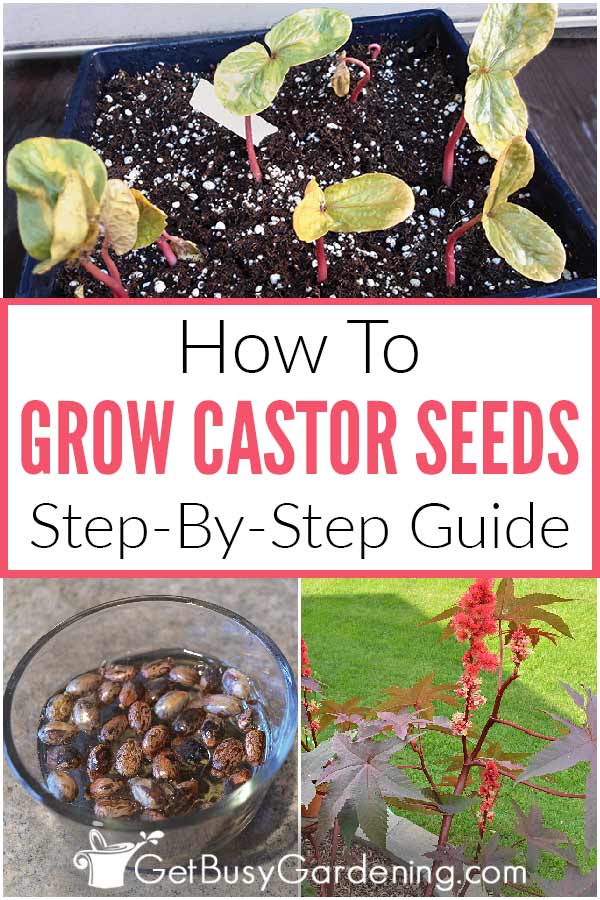
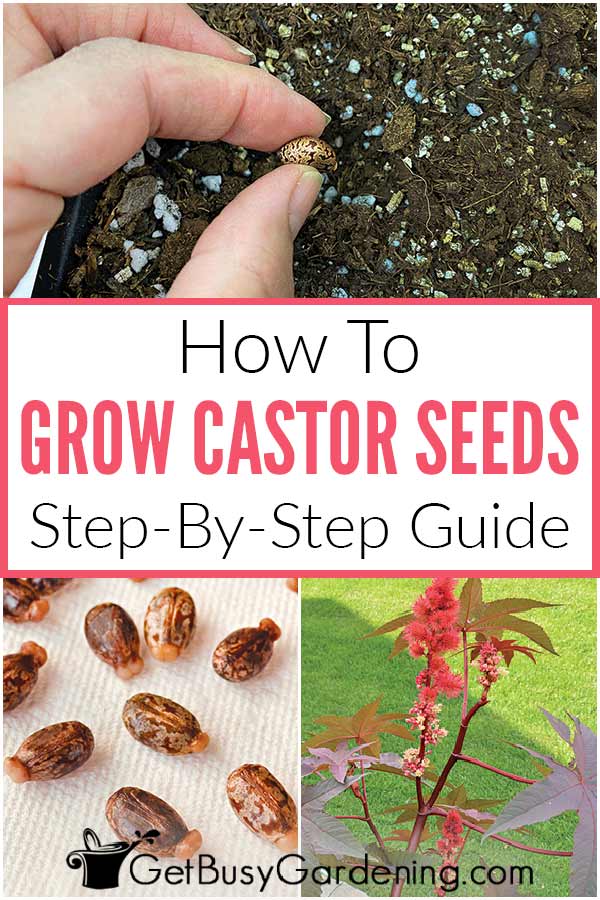
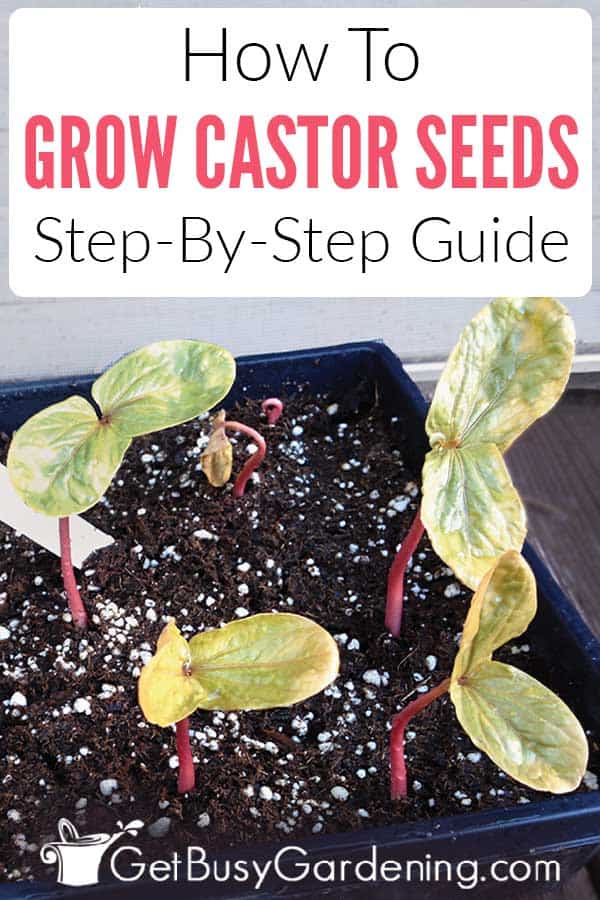

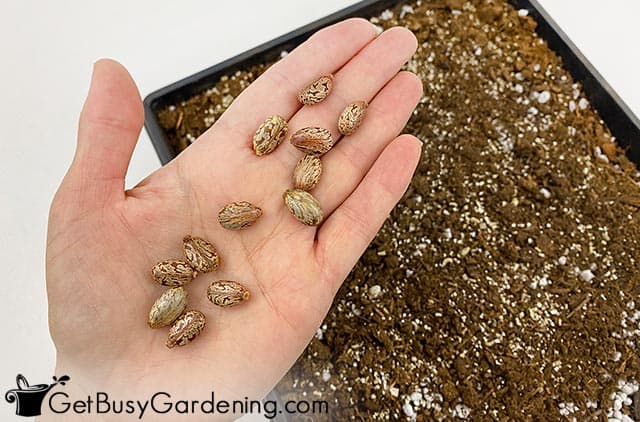
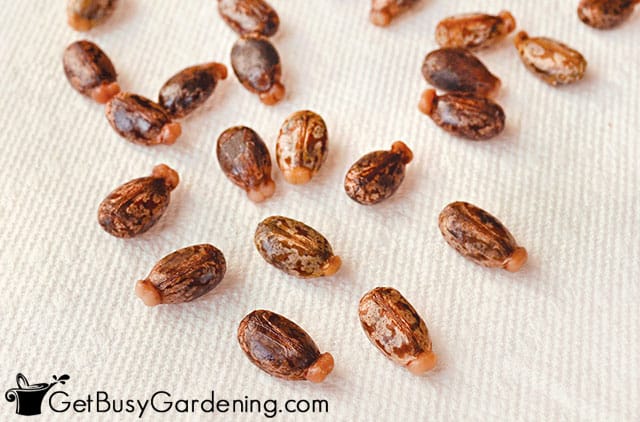
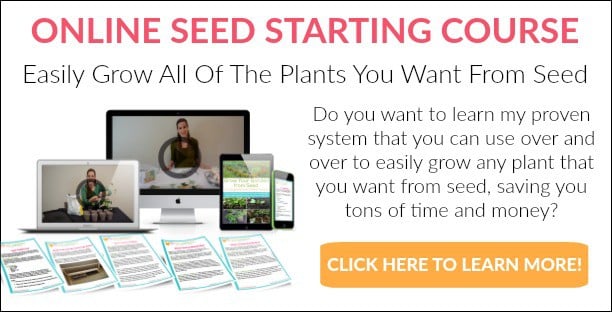

Doretta says
I grow castors every year very interesting stalks and beautiful red spikes with seeds, have a little trouble getting seeds out of shells but love them have more than hundred seeds
Amy Andrychowicz says
Yes, those spiky castor bean seed pods can be difficult to open. I wear gloves, and sometimes I need to use a nut cracker to get them open, or I use something to pry them open. Wow, what do you do with all those seeds?
Marcus says
I grew some green casstor plants last year that tolerated some frost but dropped dead when it went below 30F. This year i have 2 gibsonii varieties. One from Germany, and one from Oregon. These guys literally grow noticeably everyday. I also have a rare zanzibar variety, a giant zanzibariensis variety, and I will be getting a bright red armencita in. I researched these plants and they say to space the plants with at least 6 “true” leaves 7ft apart. I planted a green castor bean last year in SD and it grew to about 7-8ft with leaves 2.5ft across. 3in wide trunk and it well had a pile of dead flies on the ground. The seedlings grow at a rate I estimate 1/6in every day. I recently had two zanzibariensis beans germinate in 1 1/2 days in PURE water. Freaked me out because I am always seeing 10-21 days. I know they germinated because when they do, their seed shell breaks open due to the seed swelling due to germination. I have extremely good luck with wrapping them up in a warm moistened paper towel in a Ziploc baggy near a heat vent. I shall include a link to the German gibsoniis because well, if your like me then you will realize that this particular kind is VERY beautiful. I also found a gibsonii that is cold hard to zones 5-11. (perennial in zones 7-12 apparently).
Amy Andrychowicz says
Awesome, thanks for the info! Castor seeds do swell, and the small nub on the side pops out after soaking… but that doesn’t mean they have germinated. So maybe that’s what you were seeing after soaking them for 1 1/2 days? I haven’t tried germinating them with the paper towel method yet, but I am totally going to experiment with that this year!
Will says
Your German castor verity sounds interesting zone 6 ere so start fresh seeds each year here…..
Jeff Mehlhorn says
I grow castor beans (Zanzibariensis cultivar) in my garden every year, and they grow fast!
Amy Andrychowicz says
Yes, they are awesome!
Melanie says
I am so proud of growing my first castor beans!! I live in the south, so I am going to try to keep them from dying this winter. Is this possible? They are kind of leggy, if they survive should I trim them back in spring? I’ve harvested beans just in case. Thanks,
Melanie
Amy Andrychowicz says
It depends on the variety of castor bean plant you have. Some are hardy down to zone 8, and will live for years. Some are only annuals, and will die after a year, but can reseed themselves. If you have a shrub variety, and you can protect it from frost and freezing, it should survive for you just fine.
johnny blatz says
I have a caster bean growing in my back yard that is close to 14 feet high and probably 5 feet accross.
Amy Andrychowicz says
Sounds wonderful!
kayte says
Hi Amy
I have tried planting my castor seeds straight in the pot to start without luck. Thanks for the tip about soaking them. I will try that in the spring. As well, I got my seeds from my neighbour and his plants come up every year about 7′ tall for the past 7 years I’ve been here.They are beautiful each and every year. Might this be a different variety of Red Castor here in Southern Ontario,Canada?
Amy Andrychowicz says
You’re welcome! I think there are a few different varieties of the red castor bean plant. Yours may be different, but the seed germination steps are the same for all. Some types are hardy down to USDA zone 5, which could be why your neighbors castor plant reseeds itself every year. Very cool!
Elizabeth says
i planted my castor plants from seeds someone gave me. i live in ohio and they come back every year on their own. i have given some of the seeds to my neighbor which they planted and theirs come back every year also but not quite as tall as mine
Amy Andrychowicz says
Very cool! A few types of castor plants are hardy down to zone 5, so that must be the type you have. They reseed themselves, that’s why the come back for you every year.
greg schrand says
I grow castor beans every year by selecting a few sprouting plants from the hundreds of volunteers that sprout from the previous year’s dropped seeds. I just nurture the few that happen to be in the locations I desire. I also harvest the seeds in case I or anyone needs them. I have had strangers knock at my door to ask what the plants are–mine usually grow up to twenty feet tall (full sun all day and some fertilizer). The seeds are poisonous, I don’t know about the leaves.
Amy Andrychowicz says
Funny, I have heard castor plants can be invasive in warmer climates. They don’t reseed themselves here in Minnesota. Wow, 20 feet tall?? Mine have never gotten taller than 5-5 1/2 feet. You must have the giant variety, sounds amazing! All parts of the plants are poisonous, including the leaves.
Linda says
I have planted castor bean plants for years in my garden and have collected their seeds. I have never soaked them before this year. Very interesting. I was wondering if the swollen nub is the root or the stalk coming out? Which way is down when planting the seed. I had always just laid them in the pot.
Amy Andrychowicz says
Yes, I just lay them in the pot too. There’s not really a right or wrong way to plant castor seeds. The seedlings know which way is up. 🙂
Dina says
Thanks for all this wonderful information about growing castor seeds…I have a question…after the 24 hour soaking…and the knob pops out of the seed…is that the root or the stem of the plant? Should I plant the bean in the dirt with the knob up?
Amy Andrychowicz says
I’m not sure, I’ve never dug them up to see (I should do that next time!). It doesn’t matter which end you plant up, castor seedlings will find their way up. I just lay them on their sides when I plant them.
Marge says
I ordered Sanguineus Castor Bean seeds online. The seeds that I received or microscopically small and they appear black. They do not look anything like your picture. Did I get the wrong seeds? What type of Castor Bean plant is pictured here?
Amy Andrychowicz says
Hi Marge,
They are definitely not the same seeds as mine. The ones I have are the size of a kidney bean, maybe a little larger. You might have gotten seeds for a different variety of castor bean, but I’m not sure. Here is the castor bean plant that I have… Red Castor Bean Plant
Anonymous says
I bought my first castor last year and saved as many seeds as I could, for planting and trading. I dont think I can justify buying more plant s this year so will be trading for things I reaally want
Amy Andrychowicz says
Awesome! Seed trading is so much fun and you can fill a whole garden for pennies! Just make sure you tell the people you’re trading with that castor seeds are poisonous. I got some in a trade once, and they did not tell me they are poisonous! Yikes!
smallhousebiggarden says
I have a question. My castor bean seeds are just now germinating(I've noticed little pink shoots) Is this "pink" part of what will be the stem? or is it part of what will continue to grow underground as root? I ask because we had torrential rains and some of these direct sown seeds were brought up toward the surface. they appear to be on their sides and I was wondering what part to shove back down so I don’t loose these potential plants
p.s. I’ve never grown castor seeds before so am a bit uncertain of what’s what!
Amy Andrychowicz says
Yes, those pink things will end up being part of the stem. My castor seedlings sometimes try to pop out of the ground too, but the roots find their way back in. I don't think you need to worry about pushing them down. Give them some time to figure out where to grow, and then it will be obvious which part is the stem and which part is the roots. If they still keep growing sideways, then you will know which end to bury. Good luck with them, I hope they will grow well for you.
Mambeu says
only if u eat a handful
Amy Andrychowicz says
LOL, yes, only if you eat them.Amy
Glenda Heffren says
Do castor bean plants come back every yr. or do you have to plant new beans?
Amy Andrychowicz says
Castor plants are annuals. So, you have to replant the seeds every year.
Michael Keller says
Or..If you life in a very mild climate, or you lived in an area that has had a mild winter. It is August, and I am sill cutting down dozens of volunteer plants that keep popping up in my lawn from last year’s plant’s. To give you some idea where the Zone is in which we live, we live in St. Louis, MO.
This mild winter, I didn’t have to dig up my Elephant Ears, either. This year, their leaves wee 5 feet x 4 feet!
I have a couple “Giant” castor Bean plants that have not yet produced seed pods that came from seed the saved from last year. I have also used the same seed for the plantings in our flower beds. They they have turned into “normal” Castor Bean” flowers.
I gave my neighbor 4 to 5 seeds that I had left of from last year, and she has a “Giant” growing in her flower beds, too! Mind you, these plants have no yet set a single seed on them, and both plants, my single plant and he single plant, are taller than our homes by several feet!. They are not the ‘Green’ variety, which is known to grow very tall, but these are ‘reds’ which don’t grow much over 10 – ft 12 tall.
Does anybody know any way I can propagate these two plants without seeds? maybe agar peri dish style???
Amy Andrychowicz says
Wow, sounds amazing! I’m not sure how else you could propagate castor plants. They might still have time to set seed. I usually don’t harvest the seeds until October here in Minnesota.
Anonymous says
Aren't these beans poisonous?
Amy Andrychowicz says
Yes, all parts of the plant are poisonous.Amy
Ricin Rodeo says
Castor Plants have ricin.
Amy Andrychowicz says
Yes, they are poisonous, you definitely do not want to eat them!!
Anna says
Following your advice (sorta), I had a few spikes of nice seed pods from my castor beans. I left them out past a hard frost that destroyed the rest of the plants including a couple of the spikes of seed, but the three huge spikes I did grab look fine. I've been drying the spikes in my laundry room up high from grabby hands since.
This morning I got antsy and decided to try opening a pod up. The castor seeds inside are large and I think feel like I remember them feeling – but they feel slightly hollow on the top. A ver small spot though. I see by your photo that your seeds floated pretty well, so I’m assuming this i normal. I can’t remember if mine floated around like that or not when I soaked my castor seeds before germination, but I do remember that swollen little nub that they form when they’re ready. Anyway, the rest of the seeds looks good – nice and fat, but with a slightly waxyish coating. Not sure if this i normal either. My pods haven’t split, but are really dry… I’m wondering if I should just let the spikes dry over the entire winter and collect the seed in the spring before I soak them?
Amy Andrychowicz says
Sounds like you’re doing everything right. I usually store my castor seeds in the pods because I'm too lazy to pop them all out in the fall. I pop them out of the pods when it's time to germinate them in the spring. 🙂 You could store them either way.
After soaking castor seeds, the swollen nub is important. There were a few seeds that I soaked where the nub didn’t pop out, and they never grew. They were also smaller than the rest of the seeds. Yes, the seeds floated, but I seem to remember some of them had sunk by morning. I can’t remember for sure. Good luck with germination!
Ricin Rodeo says
Does the nub have to pop out?
Amy Andrychowicz says
I don’t think it is required, but the nubs pop out on all of mine. It might be different for other varieties of castor bean though.
Ricin Rodeo says
I do have. green castor plants, not red
joanne Montgomery says
Hi Amy . What is the best way to store the seeds ? I live in southern Canada so I will need to plant my castor seeds the spring . This is the first time i planted them in my garden I think they are just beautiful . We call them Canadas tropical plant … Thanks
Amy Andrychowicz says
Let them dry completely before you store them. I store them in a paper bag in a closet in my basement (along with all my other seeds), and just leave them in the seed pod all winter. You could remove them from the seed pod now if you prefer, either way is fine. Wherever you choose to store them, make sure to keep them out of reach of pets and children at all times. Here’s more information about how I store my seeds… Storing Seeds
joanne Montgomery says
Thanks Amy for the info , sorry if i seem a little dense but is the redish /pink flower the pod ?
Amy Andrychowicz says
Yes, those pink things that look like pompoms will become the seed pods. Leave them on the plant and they will eventually turn brown and dry out, they might even start to bust open. That’s when they’re ready to harvest. You’ll find the seeds inside there. Here’s a post I wrote that has instructions for collecting the seeds… How to Collect Castor Bean Seeds
shelley says
can you plant the seeds while they are in there pods
Amy Andrychowicz says
I would not. The pods are pretty hard, and that might limit the ability for the castor seeds to germinate. But if you have a lot of seeds to spare, you could experiment.